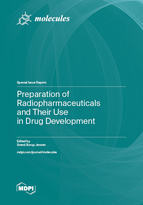Preparation of Radiopharmaceuticals and Their Use in Drug Development
A special issue of Molecules (ISSN 1420-3049). This special issue belongs to the section "Medicinal Chemistry".
Deadline for manuscript submissions: closed (30 May 2015) | Viewed by 87715
Special Issue Editor
Interests: radiochemistry; radiopharmacy; GMP-production; drug degradation; receptor kinetics; analytical methods; chelation; medicinal chemistry
Special Issues, Collections and Topics in MDPI journals
Special Issue Information
Dear Colleagues,
The journals Molecules and Pharmaceuticals will jointly be publishing a Special Issue covering the topic "Preparation of Radiopharmaceuticals and Their Use in Drug Development". I would like to invite you to make submissions addressing topics regarding Preparation of Radiopharmaceuticals with the aim at exploring their potential use in Drug Discovery.
The use of radiopharmaceuticals in drug development has many different applications.
Labeling a potential drug with a radionuclide for imaging and inject radiopharmaceuticals into animals or human can immediately give information about the in vivo destiny of the compound by applying PET- or SPECT scanners Does a radioactive drug accumulation in the site where the drug is supposed to have its effect or does it not reach the target organ or tumor at all? If radionuclides are employed throughout the whole process of developing new drugs, especially if the results are negative and the potential drug can be discarded early on in the process, a lot of effort and money can be saved. An alternative way of obtaining information about the in vivo destiny/effect of a potential drug is to imagine, for example, a target organ or a tumor with radiopharmaceuticals before and after treatment with a drug. This technique will most likely be widespread when it comes to personalized medicine, when a scan with a radiopharmaceutical can determine if a certain drug has its desired effect or if the physician has to try something else.
Determining how a drug is metabolized is an integrated part of drug development. Labeling a drug with radionuclide giving it a radioactive tag can help to find it subsequently and to quantify metabolites. If the metabolites can be extracted, the solutions can be examined by common analytical measurements. If the metabolites are incorporated into tissue and for that reason more difficult to find, a quick radioactive measurement can determine which tissue samples contain metabolites and/or radioactive labeled drug.
Using ionizing radiation in the treatment of tumor is also an application for radiopharmaceuticals which is expected to expand greatly in the years to come. By labeling a specific compounds with a radionuclide used for diagnostics we can see if it accumulates in the tumor. The same compound is thereafter combined with a radionuclide for treatment.
The purpose of this Special Issue is to host research and review papers on the Preparation of Radiopharmaceuticals and their potential use in Drug Discovery
Dr. Svend Borup Jensen
Guest Editor
Manuscript Submission Information
Manuscripts should be submitted online at www.mdpi.com by registering and logging in to this website. Once you are registered, click here to go to the submission form. Manuscripts can be submitted until the deadline. All submissions that pass pre-check are peer-reviewed. Accepted papers will be published continuously in the journal (as soon as accepted) and will be listed together on the special issue website. Research articles, review articles as well as short communications are invited. For planned papers, a title and short abstract (about 100 words) can be sent to the Editorial Office for announcement on this website.
Submitted manuscripts should not have been published previously, nor be under consideration for publication elsewhere (except conference proceedings papers). All manuscripts are thoroughly refereed through a single-blind peer-review process. A guide for authors and other relevant information for submission of manuscripts is available on the Instructions for Authors page. Molecules is an international peer-reviewed open access semimonthly journal published by MDPI.
Please visit the Instructions for Authors page before submitting a manuscript. The Article Processing Charge (APC) for publication in this open access journal is 2700 CHF (Swiss Francs). Submitted papers should be well formatted and use good English. Authors may use MDPI's English editing service prior to publication or during author revisions.
Keywords
- radioactive isotopes
- PET and SPEC molecules
- radiopharmaceuticals
- quality control
- Purification techniques
- ionizing radiation
Related Special Issue
- Radiopharmaceuticals in Molecules (24 articles)







